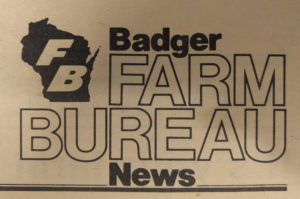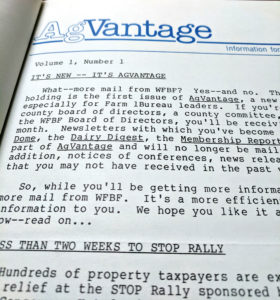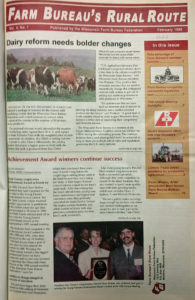Communication Changes Through the Years
As Wisconsin Farm Bureau celebrates its centennial, the organization has been looking at different aspects of its history.
The way Farm Bureau has communicated with members might be one of the most drastic changes. The organization recognized early on that not only were county meetings with field supervisors important but that a coordinated media and member communications strategy was also required.

In the 1920s, Farm Bureau members in several counties received Wisconsin Farm Bureau News, written for county Farm Bureaus.
By 1930, WFBF had its own publication for the first time, edited by E.E. Schroeder. This publication however it did not have a name.
The WFBF Board of Directors decided that it would have a contest to determine a name for the publication. The winner, Clara Thoreson from Chilton, submitted the name, ‘Badger Farm Bureau News’ and was awarded a $10 gold piece.

The Badger Farm Bureau News was a regular publication from 1930 through 1985, when it was replaced by the bi-monthly magazine Ag Venture. In addition, from 1985 through 1992 WFBF published AgVantage, a bi-monthly newsletter for county Farm Bureau leaders. In 1994, Frontline, a monthly newsletter, was added to complement AgVenture as a regular tool to get timely and useful information to members.
Weekly radio communications produced by WFBF Communications Director Gail Hamilton in the 1970s, were replaced in the 1980s with Farmline radio news network.

In 1995, Ag Venture was replaced by Farm Bureau’s Rural Route. This publication, which started as a newsletter, slowly adapted from a newspaper to the glossy magazine you enjoy reading today.
As communication efforts expanded in society, Farm Bureau jumped in with new tactics.
Press releases, editorials, news conferences and interviews were used to get Farm Bureau’s name in the news.
In the 2000s, more digital communications were a focus.
Ag Newswire, a weekly email containing agricultural news, was added to make sure members, legislators and media personnel were reading rural headlines.
Social media was added as part of the growing demand for quick digital news. Farm Bureau also maintains a website for members and prospective members to learn more about the organization.
Farm Bureau continues to adapt to ever-changing technology. Most recently a redesign of WFBF’s website made the site easier to use but most importantly, mobile friendly and searchable. The site also premiered an online membership application.
Farm Bureau will no doubt continue to change its communication strategy as technology transforms; however, the importance of keeping members ‘in the know’ will never be outdated.


Leave a Reply